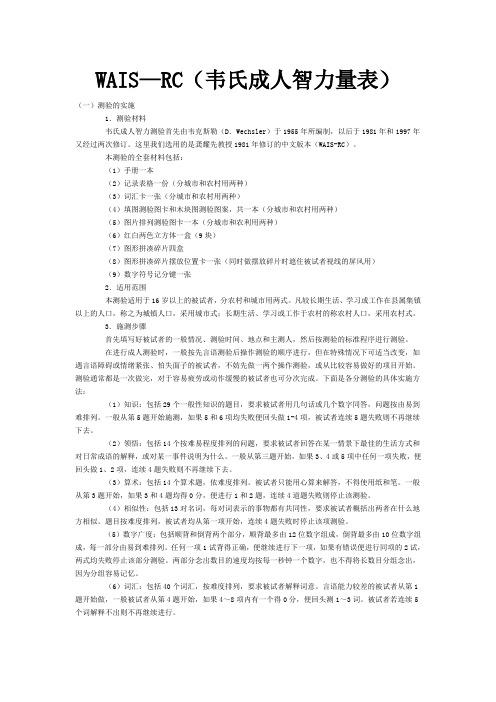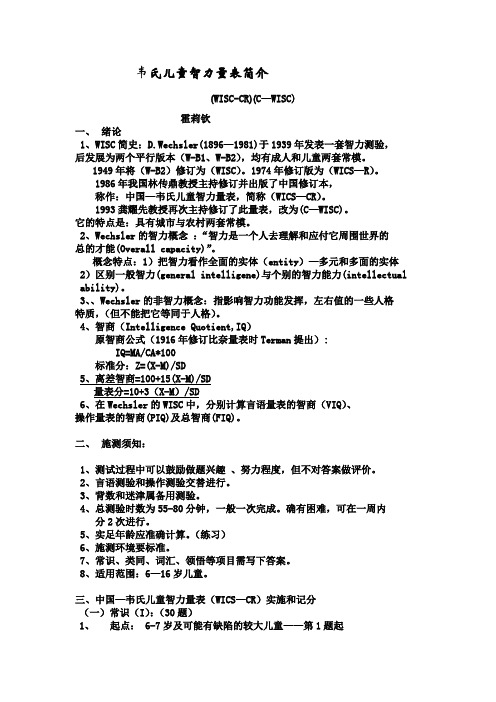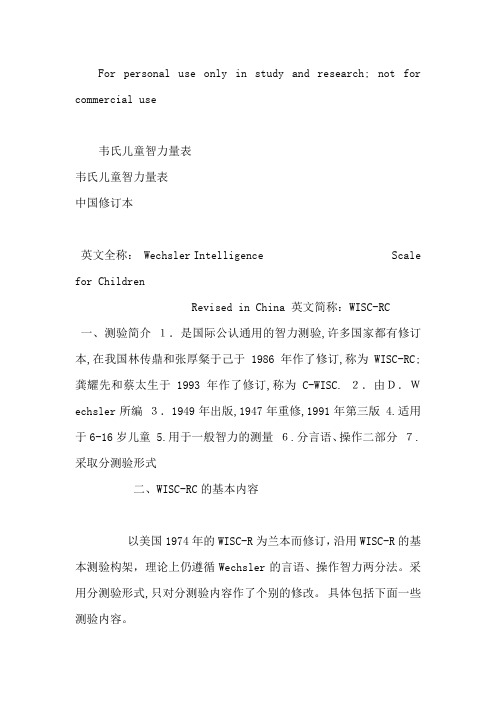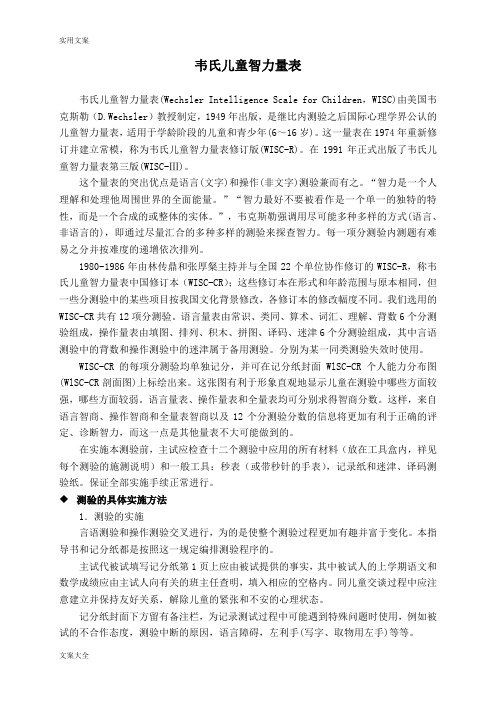韦氏智力量表
WAIS—RC(韦氏成人智力量表)

WAIS—RC(韦氏成人智力量表)(一)测验的实施1.测验材料韦氏成人智力测验首先由韦克斯勒(D.Wechsler)于1955年所编制,以后于1981年和1997年又经过两次修订。
这里我们选用的是龚耀先教授1981年修订的中文版本(WAIS-RC)。
本测验的全套材料包括:(1)手册一本(2)记录表格一份(分城市和农村用两种)(3)词汇卡一张(分城市和农村用两种)(4)填图测验图卡和木块图测验图案,共一本(分城市和农村用两种)(5)图片排列测验图卡一本(分城市和农利用两种)(6)红白两色立方体一盒(9块)(7)图形拼凑碎片四盒(8)图形拼凑碎片摆放位置卡一张(同时做摆放碎片时遮住被试者视线的屏风用)(9)数字符号记分键一张2.适用范围本测验适用于16岁以上的被试者,分农村和城市用两式。
凡较长期生活、学习或工作在县属集镇以上的人口,称之为城镇人口,采用城市式;长期生活、学习或工作于农村的称农村人口,采用农村式。
3.施测步骤首先填写好被试者的一般情况、测验时间、地点和主测人,然后按测验的标准程序进行测验。
在进行成人测验时,一般按先言语测验后操作测验的顺序进行,但在特殊情况下可适当改变,如遇言语障碍或情绪紧张、怕失面子的被试者,不妨先做一两个操作测验,或从比较容易做好的项目开始。
测验通常都是一次做完,对于容易疲劳或动作缓慢的被试者也可分次完成。
下面是各分测验的具体实施方法:(1)知识:包括29个一般性知识的题目,要求被试者用几句话或几个数字同答,问题按由易到难排列。
一般从第5题开始施测,如果5和6项均失败便回头做1-4项,被试者连续5题失败则不再继续下去。
(2)领悟:包括14个按难易程度排列的问题,要求被试者回答在某一情景下最佳的生活方式和对日常成语的解释,或对某一事件说明为什么。
一般从第三题开始,如果3、4或5项中任何一项失败,便回头做1、2项,连续4题失败则不再继续下去。
(3)算术:包括14个算术题,依难度排列。
韦氏儿童智力量表简介

韦氏儿童智力量表简介(WISC-CR)(C—WISC)霍莉钦一、绪论1、WISC简史:D.Wechsler(1896—1981)于1939年发表一套智力测验,后发展为两个平行版本(W-B1、W-B2),均有成人和儿童两套常模。
1949年将(W-B2)修订为(WISC)。
1974年修订版为(WICS—R)。
1986年我国林传鼎教授主持修订并出版了中国修订本,称作:中国—韦氏儿童智力量表,简称(WICS—CR)。
1993龚耀先教授再次主持修订了此量表,改为(C—WISC)。
它的特点是:具有城市与农村两套常模。
2、Wechsler的智力概念:“智力是一个人去理解和应付它周围世界的总的才能(Overall capacity)”。
概念特点:1)把智力看作全面的实体(entity)—多元和多面的实体2)区别一般智力(general intelligene)与个别的智力能力(intellectual ability)。
3、、Wechsler的非智力概念:指影响智力功能发挥,左右值的一些人格特质,(但不能把它等同于人格)。
4、智商(Intelligence Quotient,IQ)原智商公式(1916年修订比奈量表时Terman提出):IQ=MA/CA*100标准分:Z=(X-M)/SD5、离差智商=100+15(X-M)/SD量表分=10+3(X-M)/SD6、在Wechsler的WISC中,分别计算言语量表的智商(VIQ)、操作量表的智商(PIQ)及总智商(FIQ)。
二、施测须知:1、测试过程中可以鼓励做题兴趣、努力程度,但不对答案做评价。
2、言语测验和操作测验交替进行。
3、背数和迷津属备用测验。
4、总测验时数为55-80分钟,一般一次完成。
确有困难,可在一周内分2次进行。
5、实足年龄应准确计算。
(练习)6、施测环境要标准。
7、常识、类同、词汇、领悟等项目需写下答案。
8、适用范围:6—16岁儿童。
三、中国—韦氏儿童智力量表(WICS—CR)实施和记分(一)常识(I):(30题)1、起点: 6-7岁及可能有缺陷的较大儿童——第1题起8 -10岁儿童——第5题起(连两题0分倒退,至连两题1分) 11-13岁儿童——第7题起14-16岁儿童——第11题起。
韦氏儿童智力量表第四版

矩阵推理 Matrix Reasoning
• 非语言的概念形成,抽象思考推理,问题解决 能力,
• 主要测量的能力:非言语的推理和解决问 题的能力、分析能力以及空间知觉和空间 辨别能力,
填图 pictures completion
• 对熟悉物体的缺陷的视觉辨认、区分主要 次要、注意环境细节、推理能力
韦氏儿童智力量表第四版
WISC-IV中文版
韦氏智力量表
成人
儿童
婴幼儿
WAIS-IV 2008 WISC-IV 2003
WAIS-III 1997 WISC-III 1991 WPPSI-III 2002
WAIS-R 1981
WAIS 1955
WISC-R 1974
WISC 1949
WPPSI-R 1989 WPPSI 1967
• 基本算术知识以及对算术问题同时进行存 储、加工以及推理的心理运算能力,
• 主要测量能力: 记忆力、数字推理能力、注意力、心理运
算操作 同时涉及语言理解能力,
加工速度指数 PSI
心理操作与动作的速度/视知觉信息的处 理能力 正确快速扫描、排序、辨别 • 快速操作视觉信息 • 视觉记忆/视知觉选择性注意 • 视觉-动作协调 • 警觉性
常 识 Information
• 有环境中习得的一般知识的广度 • 主要测量能力:一般知识广度、获取,保存,
提取一般知识的能力
知觉推理指数 PRI
知觉推理、视觉 空间 信息处理、视觉动 作的整合组织能力, • 依据视觉形象思考的能力 • 能流畅迅速处理视觉信息 • 能根据视觉信息思考、而不用字词 • 能快速解释视觉信息
字母-数字排序Lertter-Number Seq
韦氏儿童智力量表

For personal use only in study and research; not for commercial use韦氏儿童智力量表韦氏儿童智力量表中国修订本英文全称: Wechsler Intelligence Scale for ChildrenRevised in China 英文简称:WISC-RC一、测验简介1.是国际公认通用的智力测验,许多国家都有修订本,在我国林传鼎和张厚粲于己于1986年作了修订,称为WISC-RC; 龚耀先和蔡太生于1993年作了修订,称为C-WISC. 2.由D.Wechsler所编3.1949年出版,1947年重修,1991年第三版 4.适用于6-16岁儿童 5.用于一般智力的测量6.分言语、操作二部分7.采取分测验形式二、WISC-RC的基本内容以美国1974年的WISC-R为兰本而修订,沿用WISC-R的基本测验构架,理论上仍遵循Wechsler的言语、操作智力两分法。
采用分测验形式,只对分测验内容作了个别的修改。
具体包括下面一些测验内容。
言语分量表操作分量表1.常识 7.填图2.类同 8.排列3.算术 9.积木4.词汇 10.拼图5.理解 11.译码6.背数12.迷津三. 各分测验的主要功能、实施方法和记分标准 WISC-CR实施和记分原则 WISC-CR的实施和记分原则与WAIS-RC类似。
为保持儿童对测验的兴趣,避免疲劳和厌倦,言语分测验和操作分测验交替进行。
背数 ,但非被选和迷津成人无是备选分测验,一般情况下不做,只当同类测验中某项失效时才使用。
城市、农村儿童共用一个版本。
1 常识测验内容与功能:由30个常识问题构成,包括历史、天文、地理、文学和自然等内容。
主要测量知识广度和远事记忆。
实施方法:指出特定事物之事实,连续5项失败(得0分)终止。
评分标准:每正确回答一项记1分,个别项目记0.5分,最高30分。
测验问题和标准回答 1. 这个指头叫什么? 大母指 2. 人有几个耳朵?二个 3.狗有几条腿? 2 填图测验内容与功能:由26幅有缺失的图画构成,要求找出说出或指出缺失部分的名称。
WAIS—RC(韦氏成人智力量表)

WAIS—RC(韦氏成人智力量表)(一)测验的实施1.测验材料韦氏成人智力测验首先由韦克斯勒(D.Wechsler)于1955年所编制,以后于1981年和1997年又经过两次修订。
这里我们选用的是龚耀先教授1981年修订的中文版本(WAIS-RC)。
本测验的全套材料包括:(1)手册一本(2)记录表格一份(分城市和农村用两种)(3)词汇卡一张(分城市和农村用两种)(4)填图测验图卡和木块图测验图案,共一本(分城市和农村用两种)(5)图片排列测验图卡一本(分城市和农利用两种)(6)红白两色立方体一盒(9块)(7)图形拼凑碎片四盒(8)图形拼凑碎片摆放位置卡一张(同时做摆放碎片时遮住被试者视线的屏风用)(9)数字符号记分键一张2.适用范围本测验适用于16岁以上的被试者,分农村和城市用两式。
凡较长期生活、学习或工作在县属集镇以上的人口,称之为城镇人口,采用城市式;长期生活、学习或工作于农村的称农村人口,采用农村式。
3.施测步骤首先填写好被试者的一般情况、测验时间、地点和主测人,然后按测验的标准程序进行测验。
在进行成人测验时,一般按先言语测验后操作测验的顺序进行,但在特殊情况下可适当改变,如遇言语障碍或情绪紧张、怕失面子的被试者,不妨先做一两个操作测验,或从比较容易做好的项目开始。
测验通常都是一次做完,对于容易疲劳或动作缓慢的被试者也可分次完成。
下面是各分测验的具体实施方法:(1)知识:包括29个一般性知识的题目,要求被试者用几句话或几个数字同答,问题按由易到难排列。
一般从第5题开始施测,如果5和6项均失败便回头做1-4项,被试者连续5题失败则不再继续下去。
(2)领悟:包括14个按难易程度排列的问题,要求被试者回答在某一情景下最佳的生活方式和对日常成语的解释,或对某一事件说明为什么。
一般从第三题开始,如果3、4或5项中任何一项失败,便回头做1、2项,连续4题失败则不再继续下去。
(3)算术:包括14个算术题,依难度排列。
韦氏儿童智力量表-第四版

韦氏儿童智力量表-第四版韦氏儿童智力量表(Wechsler Intelligence Scale for Children, Fourth Edition,简称WISC-IV)是世界上最常用的儿童智力测量工具之一。
该量表由心理学家大卫·韦斯勒(David Wechsler)于1949年首次提出,经过多次修订和改进,目前已发展到第四版。
WISC-IV主要用于测量6至16岁儿童和青少年的智力水平,包括认知、思维和问题解决能力等多个方面。
它通过一系列的任务和测试,评估被试在不同智力领域的表现,并得出综合的智商指数。
WISC-IV采用了标准化的测试程序和评分标准,确保了测量结果的客观性和可比性。
量表共包含15个子测试,分为四个主要指数:言语理解指数(Verbal Comprehension Index,VCI)、知觉推理指数(Perceptual Reasoning Index,PRI)、工作记忆指数(Working Memory Index,WMI)和处理速度指数(Processing Speed Index,PSI)。
这些指数可以反映被试在语言、推理、记忆和处理速度方面的表现。
在进行测试时,被试需要完成一系列的任务,如回答问题、解决问题、完成图形拼图等。
这些任务涵盖了词汇理解、类比推理、空间能力、数学能力、记忆力和注意力等多个方面。
通过对被试的表现进行评分,可以得出各个指数的原始分数和标准分数。
除了四个主要指数,WISC-IV还提供了一个综合指数——智商指数(Full Scale IQ,FSIQ)。
智商指数是根据四个主要指数的加权得出的,可以综合评估被试的整体智力水平。
此外,WISC-IV还提供了子测试分数、指数分数和智商指数的分布图,以及与年龄和性别相匹配的标准分数。
WISC-IV的应用广泛,被用于学校、临床和研究等领域。
在教育上,它可以帮助教师了解学生的智力水平和潜能,为其提供个性化的教学和辅导。
韦氏智力测试表

韦氏智力测试表韦氏智力量表(Wechsler Intelligence Scale)由美国心理学家韦克斯勒所编制,是继比内一西蒙智力量表之后为国际通用的另一套智力量表。
韦克斯勒长期从事心理测验的编制和研究工作,为发展国际知名的智力量表做出了极大的贡献。
l939年他首先编制成韦克斯勒一贝勒维量表(W-B),司用于成人及儿童。
随后又编制出平行本,称w-BⅡ,因此称前孝为w-B l。
1949年将W-BⅡ发展和修改成韦氏儿童智力量表(Wechsler IntelligenceScalefor Children,WISC).成为继比内测验之后又一个应用最广的儿童智力量表。
1955年将w-B I修订成韦氏成人智力量表(wechsler AduIt Intelligence Scale,WAIS),使之与WISC相衔棒.l967年又编制了韦氏学龄前及幼儿智力量表(Wechsler Preschool andPrimary Scale of Intelligence,WPPSI ),至此一套从4岁幼儿到成人(74岁)的三个著名智力量表编制成功.70年代初,韦氏着手修订他自己编制的智力量表,1974年出版了韦氏儿童智力量表修订本(WISC-R)。
1981年出版了韦氏成人智力量表修订本(WAIS-R[1] 1989年出版了韦氏学龄前及幼儿智力量表修订本(WPPSl-R)。
此外,l991年出版‟r韦氏儿童智力量表第三版(WISC一Ⅲ),1997年出版了韦氏成人智力量表第三版(WAIS一Ⅲ)。
韦氏智力量表主要指WAIS-R、WISC-R和WPPSl这三个量表,三者均包括相同的分测验,因年龄关系,有一些在形式上作了一些变更,还有少数量表中的分测验有增减(见表3-4)。
注:“[ ].…内项目为在WISC-R和WPPSl中的备用分测验1979~1981年问,在龚耀先主持下完成基于WAIS的修订工作,称中国修订韦氏成人智力量表(WAIS-RC)。
(完整版)韦氏儿童智力量表(第二版)

韦氏儿童智力量表韦氏儿童智力量表(Wechsler Intelligence Scale for Children,WISC)由美国韦克斯勒(D.Wechsler)教授制定,1949年出版,是继比内测验之后国际心理学界公认的儿童智力量表,适用于学龄阶段的儿童和青少年(6~16岁)。
这一量表在1974年重新修订并建立常模,称为韦氏儿童智力量表修订版(WISC-R)。
在1991年正式出版了韦氏儿童智力量表第三版(WISC-Ⅲ)。
这个量表的突出优点是语言(文字)和操作(非文字)测验兼而有之。
“智力是一个人理解和处理他周围世界的全面能量。
”“智力最好不要被看作是一个单一的独特的特性,而是一个合成的或整体的实体。
”,韦克斯勒强调用尽可能多种多样的方式(语言、非语言的),即通过尽量汇合的多种多样的测验来探查智力。
每一项分测验内测题有难易之分并按难度的递增依次排列。
1980~1986年由林传鼎和张厚粲主持并与全国22个单位协作修订的WISC-R,称韦氏儿童智力量表中国修订本(WISC-CR);这些修订本在形式和年龄范围与原本相同,但一些分测验中的某些项目按我国文化背景修改,各修订本的修改幅度不同。
我们选用的WISC-CR共有12项分测验。
语言量表由常识、类同、算术、词汇、理解、背数6个分测验组成,操作量表由填图、排列、积木、拼图、译码、迷津6个分测验组成,其中言语测验中的背数和操作测验中的迷津属于备用测验。
分别为某一同类测验失效时使用。
WISC-CR的每项分测验均单独记分,并可在记分纸封面WlSC-CR个人能力分布图(WlSC-CR剖面图)上标绘出来。
这张图有利于形象直观地显示儿童在测验中哪些方面较强,哪些方面较弱。
语言量表、操作量表和全量表均可分别求得智商分数。
这样,来自语言智商、操作智商和全量表智商以及12个分测验分数的信息将更加有利于正确的评定、诊断智力,而这一点是其他量表不大可能做到的。
在实施本测验前,主试应检查十二个测验中应用的所有材料(放在工具盒内,祥见每个测验的施测说明)和一般工具:秒表(或带秒针的手表),记录纸和迷津、译码测验纸。
- 1、下载文档前请自行甄别文档内容的完整性,平台不提供额外的编辑、内容补充、找答案等附加服务。
- 2、"仅部分预览"的文档,不可在线预览部分如存在完整性等问题,可反馈申请退款(可完整预览的文档不适用该条件!)。
- 3、如文档侵犯您的权益,请联系客服反馈,我们会尽快为您处理(人工客服工作时间:9:00-18:30)。
Original articleClinical characteristics of hand, foot and mouth disease in Harbin and the prediction of severe casesZHOU Hong, GUO Shu-zhen, ZHOU Hao, ZHU Yue-feng, ZHANG Li-juan and ZHANG WeiKeywords: hand, foot and mouth disease; diagnosis; epidemiologyBackground Hand, foot and mouth disease (HFMD) is an emerging public health problem in China, not only threatening the health of children, but also causing tremendous loss and burden to both families and society. The aim of this study was to characterize the epidemiology and clinical features of HFMD, and to understand the key factors affecting HFMD in the Harbin region to provide scientific evidence for effective prevention and control strategies.Methods Epidemiological and clinical information from 2379 randomly chosen cases of HFMD treated at the Harbin Center for Disease Control and Prevention from May 2008 to November 2011 were analyzed. All cases were separated into common and severe HFMD, with key factors for severe HFMD analyzed using multivariable Logistic regression.Results Among the 2379 patients, 1798 were common cases and 581 severe cases, 14 of which resulted in death.Most cases were in children younger than 5 years. Morbidity peaked in July and was higher in the surrounding country and cities than in Harbin proper. Medical expenses were significantly higher for severe than for common cases (P<0.001). The primary clinical symptoms were fever and erythema; laboratory examination showed leucocytosis togetherwith pneumonia, carditis, and abnormal electrocardiogram and electroencephalogram in severe cases. Multivariable Logistic regression analysis showed that the key factors for severe HFMD were age, morbidity location, morbidity area, fever duration, mouth mucosal symptoms, and abnormal serum levels of neutrophils (NEUT), hemoglobin and glucose (P<0.05).Conclusions To improve prognosis, reduce medical expense and prevent the development of severe cases, we should improve the epidemiological detection of HFMD to treat patients quickly. We should also closely monitor children with the EV71 virus, who present with continuous fever as well as abnormal laboratory results, from areas highly susceptible to HFMD attacks.Chin Med J 2012;125(7):1261-1265and, foot and mouth disease (HFMD) is one of themost common contagious diseases caused by an enterovirus, usually enterovirus 71 strain (EV71) or coxsackie virus A Group 16 strain (CA16).1The virus may reach the brainstem and spinal cord,2 causing severe complications in patients, usually infants. The clinical manifestation is mainly maculopapule and erythema on the hands, feet, mouth, and buttocks; severe cases may also present with cephalomeningitis, cephalitis, encephalomyelitis, pneumonedema, and dysaemia.3,4 Cases of HFMD have been reported in most countries and areas of the world. In China, the first confirmed case of HFMD was reported in 1981 in Shanghai.5Today, the disease is one of the most common contagious diseases in China, with a large morbidity area and increasing morbidity. According to national statistics, HFMD is ranked second in morbidity among all contagious diseases and is the sixth leading cause of death.6Despite detailed investigations of the clinical symptoms and etiological diagnosis of HFMD, the epidemiology and clinical features of HFMD in Heilongjiang province are few, and very few reports of severe HFMD have described the key factors. In our study, we examined HFMD cases in Harbin from 2008 to 2011, and used retrospective analysis to determine the clinical features and epidemiology of HFMD. We also looked at the key factors associated with severe cases in this region, to develop effective prevention and control strategies.METHODSPatientsHFMD not only threatens the health of children, but also causes tremendous loss for both families and society. This disease has become a major public health problem for China and Asia at large. We analyzed a random sample of 2379 cases of HFMD who were admitted to the Harbin Center for Disease Control and Prevention from May 2008 to November 2011. Patients were assigned as having either common or severe HRMD, using the diagnostic code (DC) in theHDOI: 10.3760/cma.j.issn.0366-6999.2012.07.013Department of Infectious Diseases, First Affiliated ClinicalHospital of Harbin Medical University, Harbin, Heilongjiang150086, China (Zhou H, Zhu YF, Zhang LJ and Zhang W)Harbin Center for Disease Control and Prevention, Harbin,Heilongjiang 150086, China (Guo SZ and Zhou H)Correspondence to: ZHANG Wei, Department of InfectiousDiseases, First Affiliated Clinical Hospital of Harbin MedicalUniversity, Harbin, Heilongjiang 150086, China (Fax:86-451-53641561. Email: 1245537680@)guidebook published by the Ministry of Health, China.7 Common HFMD was assigned to those with fever accompanying erythema on the hands, foot, mouth, and buttocks.Patients with severe HFMD were those with the following: fever accompanying erythema on the hands, foot, mouth and buttocks, with other manifestations such as neurological impairment, respiratory disorder, dysaemia and other symptoms. The laboratory assay may show an increase in leucocytes in the peripheral blood, abnormal cerebrospinal fluid, increased blood glucose (GLU), and disorders as identified by electrocardiogram (ECG), myelencephalon magnetic resonance, chest X-ray (CX), and ultrasound cardiogram.Statistical analysisRetrospective analysis of the epidemiology, clinical and laboratory results of patients studied included analysis of sex, age, location, course of disease, neurological manifestation, erythema, fever, and laboratory assay and other tests. All data were input into EPIDATE (Epidate, Beijing, China) twice by two persons to ensure data accuracy. χ2Among 2379 HFMD patients, 1385 were male and 994 female, for a male to female ratio of 1.4:1.0; the youngest patient was 2 months, the oldest was 38 years, for an average patient age of 3.2 years. Most patients (82.6%) were children and infants <5 years and most patients who were children were under nursery care (55.2% of all patients). Children too young to go to nursery care comprised of 40.7% of all patients. Only 4.1% of patients were students. Of the 581 severe cases (24.42%), 14 died (2.41%). Statistical analysis showed an average and comparable distribution of age and sex in those with common and severe HFMD (P>0.05), but a statistically significant difference in morbidity location between groups (P <0.05).Time distributionTo determine the seasonality of infection, we analyzed the cases by month in which they presented. Results are shown in Figure 1. The morbidity of HFMD in Harbin starts to increase in April, is concentrated mainly from June to August, and reaches its peak in July. The peak number of HFMD cases reported showed a downward trend since 2008 (Figure 1).Location distributionWe analyzed the location of cases to determine regionality. Results are shown in Figure 2. Among the randomly chosen 2379 cases, 800 (33.63%) were from outside Harbin. About half, or 1200 cases (50.44%), were from four districts of the main city area (Daowai, Daoli, Xiangfang, Nangang, about 300 cases each), as shown in Figure 2.Medical expensestest, t test, and multivariable Logisticregression were performed using SPSS version 13.0software (SPSS, Inc., USA). P <0.05 was consideredstatistically significant.RESULTSEpidemiology featuresGroup distributionIn all, 2295 cases required hospitalization; the averagelength of stay was 7.5 days. The 355 severe casesFigure 1. The timedistribution of patientswith hand, foot and mouthdisease in Harbin fromMay 2008 to November2010.Figure 2.The districtdistribution of patientswith hand, foot and mouthdisease in Harbin fromMay 2008 to November2010.hospitalized incurred an average medical expense of RMB (6697.80±7273.70) Yuan. Statistical analysis showed that the difference in medical expense between common and severe HFMD was statistically significant (P <0.001).Clinical manifestationFever and accompanying symptomsIn the 1917 patients with fever (80.58%), the fever lasted an average of 2–3 days. There were 1462 fever cases in the common group (82.31%) and 455 in the severe group (78.31%). Additionally, 34 cases of common HFMD (1.89%) and 151 cases of severe HFMD (25.99%) had fever lasting longer than three days. Statistical analysis showed a statistically significant difference in the duration of fever between the groups (P <0.001).Mouth manifestationOf the 2356 cases (99.03%) with mouth endermosis, 1786 were in the common group (99.33%) and 570 in the severe group (98.11%). The difference in occurrence between the two groups was statistically significant (P <0.005).ErythemaIn all, 2350 cases had erythema (98.78%), lasting 1–8days; 65% of patients had erythema as a primary symptom. There were 1769 erythema cases (98.38%) in the common group, and 581 in the severe group (100%). The difference in occurrence between the two groups was statistically significant (P <0.001).Laboratory assayIn the laboratory assay of all 2379 cases, 1549 cases (65.11%) exhibited leucocyte >10.0×109Multivariable Logistic regressionThe 12 statistically meaningful factors mentioned above were put into a regression model along with age and location. Results of the multivariable Logistic regression analysis showed that eight factors were independent risk factors for developing severe HFMD. The statistically meaningful results (P <0.05) are shown in Table 2. Treatment and sequelaeCommon cases/L; 640 cases (26.90%) exhibited high levels of the enzyme myocardium; 963 cases (40.50%) had CX indicating bronchitis; 228 cases (9.58%) exhibited pulmonary infection. In addition, 992 cases (63.14%) showed abnormal ECG and 1684 cases (72.15%) had an abnormal electroencephalogram (EEG). Table 1 shows the laboratory results for those with severe and common HFMD, indicating that the two groups differed in a statistically significant way in terms of neutrophils (NEUT), lymphocytes (LYM), hemoglobin (HGB), GLU, bronchitis, pulmonary infection, CX, and EEG (P <0.05). Etiology assayFrom May 2008 to November 2010, 961 specimens were tested, of which 100 tested Cox1A16 positive (10.4%), 326 were EV71 positive (33.9%), and 23 were primer enterovirus (PE) positive (2.4%).Analysis on key factors for severe HFMDOne-factor analysisOne-factor analysis was performed on the epidemiological features and clinical symptoms of severe and common HFMD. The results indicated 12 key factors for severe HFMD: location, duration of fever, mouth endermosis, erythema, NEUT, LYM, HGB, GLU, bronchitis, pulmonary infection, abnormal CX, and abnormal EEG (P <0.05).Treatment should be provided for common HFMDNeutrophil (×109/L) 1791 55.41±2.43 580 57.42±5.12 0.0231 Lymphocyte (×109/L) 1791 37.12±4.03 579 35.27±5.23 0.0168 Hemoglobin (g/L) 1780 119.02±12.45 575 117.05±21.21 0.0017 Glucose (mmol/L) 1622 4.32±2.09 525 5.60±3.12 <0.0010 A lanine aminotransferase (mmol/L) 1715 20.37±15.10 560 19.34±40.21 0.2696 Aspartate aminotransferase (mmol/L) 1711 38.97±11.45 562 38.91±12.54 0.7339 A lkaline phosphatase (mmol/L) 1710 208.17±22.12 560 209.39±24.21 0.5101 Lactate dehydrogenase (U/L) 1709 227.35±10.89 561 229.82±11.00 0.5101 C reatine kinase (U/L) 1711 20.39±2.41 554 20.37±3.01 0.9865 Creatine kinase-MB (U/L) 1720 42.53±3.12 561 41.46±2.09 0.4848 Bronchitis*1118 62.21% 297 51.12% <0.0010679 37.79% 284 48.88%Pulmonary infection*1639 91.16% 512 88.12% 0.0309159 8.84% 69 11.88%Chest X-ray*1091 60.71% 276 47.59% <0.0010706 39.29% 304 52.41%E lectroencephalograph*465 26.36% 185 32.46% 0.00481299 73.64% 385 67.54%Electrocardiograph*405 35.71% 174 39.82% 0.1309729 64.29% 263 60.18%*Up rows denote symptoms did not happen (normal); down rows indicate symptoms occured (abnormal).Table 2. Multivariable Logistic regression analysis on key factors for severe HFMDFactors Estimate SE Wald P values OR 95% CI Age 0.9897 0.1219 65.9317 <0.0010 2.690 2.119–3.416 Location −0.7894 0.1526 26.7589 <0.0010 0.454 0.337–0.612 Area−0.0537 0.0209 6.6194 0.0101 0.948 0.910–0.987 Duration of fever −1.8243 0.1007 328.3428 <0.001 0.161 0.132–0.197 Mouth endermosis 2.2878 0.6701 11.6569 <0.001 9.853 2.650–36.639 Neutrophil −0.2449 0.0952 6.6147 0.0101 0.783 0.650–0.943 Hemoglobin 0.4366 0.1720 6.4458 0.0111 1.547 1.105–2.168 Glucose −0.6350 0.1092 33.7869 <0.0010 0.530 0.428–0.656according to published guidelines.7 For common HFMD, conventional therapy includes patient isolation to prevent cross-infection and treating symptoms, such as fever, using combined traditional Chinese and western medicine.Severe casesTreatment for severe HFMD should be provided according to published guidelines.7 All pediatric patients should be treated with anti-viral therapy and fever reducer. Additional intensive treatment should include: (1) IV large-dose gamma globulin, total dose 2 g/kg, administered over 2–3 days; (2) Sou-Medrol therapy (1–2 mg ⋅kg -1⋅d -1 for common cases; 5–10 mg ⋅kg -1⋅d -1 for severe cases; 15–20 mg ⋅kg -1⋅d -1 for dying cases), the dose to be reduced after three days, and a small dose given on the fourth day; (3) 20% mannitol 1–2 g·kg -1·time -1HFMD is a contagious diseases caused by an enterovirus discovered in New Zealand in 1957.), within 20–30 minutes intravenous drip, albumin and furosemide added if necessary; and (4) respiration support, including timely performance of a trachea cannula and ventilation using a positive pressure respirator. When pediatric patients exhibit symptoms involving the central nervous system, such as a change in consciousness, headache, vomiting, general fatigue, trembling or convulsion, treatment should be given to alleviate symptoms quickly and then treatment for HFMD administered slowly, keeping the child slightly dehydrated. When pediatric patients exhibit symptom involving the circulatory system, such as paleness, cardiac arrhythmia, weak or no pulse, body cooling, cyanosis, or sharp change in blood pressure, treatment should be supplied quickly to alleviate symptoms slowly. To rapidly correct disorders of the circulation system, the best order of treatment is to give gamma globulin, then blood plasma and albumin in the blood transfusion. When pediatric patients exhibit respiratory distress with the primary infection, a timely trachea cannula should be performed and then the patient ventilated using a positive pressure respirator. In severe cases in this group, 14 died and all the rest recovered after 7–14 days.DISCUSSION8 After that, the disease spread globally. Each year since the first case was reported in China in 1981, this disease has been reported in more cities. On May 2, 2008, the Ministry of Health classified HFMD as a class C contagious disease,9 and thegovernment of each province and city started programs of strict detection and management.Harbin is in the northeast of China, with unique weather, geography and culture. The epidemiological results of this study showed that HFMD patients are mostly children younger than 5 years, consistent with previous reports of this disease.10 Among patients, children who are under nursery care had the highest morbidity. This is because the nursing institution is a location where children gather and eat and play together. HFMD can be transmitted through bodily contact and respiratory tract droplets.11,12 Therefore, managers of nursing institutions should pay strict attention to disinfection management, making sick children stay home.13 Teachers as well should know about HFMD so they can identify sick children to reduce the spread of infection. The time distribution analysis in this study shows that the morbidity peak is from June to August, late summer in Harbin; the virus is adapted to flourish in a wet and hot environment. In urban areas, the high morbidity results from the large, highly mobile population. In the surrounding cities, the high morbidity is due to poor health habits and living conditions.11HFMD is a self-limited disease, This fact indicates the need for a practical plan to prevent and control contagious disease in schools, and enhance morning check to identify new patients quickly. In the surrounding cities, the government should increase public health efforts, improve living conditions, and encourage the adoption of healthy habits.Because of the imbalance in regional economic development, Harbin remains relatively poor with low per capita income. For the cases in this study, the medical expense, especially for severe cases, was relatively high, representing a significant economic burden to an average family. This fact indicates that we must enhance HFMD detection, identify it earlier and treat it earlier, to decrease the morbidity of HFMD and reduce the number of common cases that convert to severe. In the meantime, we should also increase the level of clinical service to decrease the medical expenses associated with this disease.14 the prognosis is usually good, but some cases develop severe clinical manifestations. Our clinical data indicated that although all cases with clinical symptoms of HFMD present with different symptoms, the primary symptoms are mainlyfever and erythema. Some severe patients have a body temperature >39°C, and may appear lethargic, drowsy, vomit frequently, are nervous, tremble, and even convulse. Some pediatric patients appear irritable, have difficulty breathing or may exhibit tachycardia or bradycardia. These symptoms indicate that doctors should consider accompanying cerebritis, meningitis, carditis or even possible neurogenic pulmonary edema. They should thus perform CX and ECG if necessary, and treat aggressively, to improve prognosis.Non-standard treatment of severe cases will lead to death. In 2008, HFMD was widely prevalent in the Fuyang area of the Anhui province; 90 patients had severe HFMD, of whom 22 died.13 In the cases in our study, 14 children with severe HFMD died. Therefore, to reduce the incidence and mortality from severe HFMD, doctors and health care providers need to understand the risk factors for HFMD, especially for severe cases, and to practice prevention and control measures. Logistic regression analysis of the data in our study found seven key factors for severe HFMD that can provide an early warning for its presence: age, location, area, duration of fever and mouth mucosal symptoms, elevated NEUT, HGB and GLU. The duration of fever was proportional to the risk of severe disease, which is consistent with other studies.15,16 The results indicate that those younger than 5 years infected by EV7117 are the most likely of common cases to develop into severe ones. When receiving pediatric patients from a nursery care institution or from surrounding cities with high HFMD morbidity, one should consider the possibility of EV71 infection in the presence of persistent fever and indicative laboratory results. It is important to try to identify severe patients early and provide appropriate treatment, to reduce the morbidity and number of severe cases.18Acknowledgement: We are grateful for the information on the hand, foot and mouth disease provided by Harbin Center for Disease Control and Prevention.REFERENCESIn our study, among laboratory criteria, abnormal levels of NEUT, HGB and GLU were key factors for identifying severe cases. These factors can be used to identify cases requiring aggressive treatment.1.Wong KT, Munisamy B, Ong KC, Kojima H, Noriyo N, Chua KB, et al. The distribution of inflammation and virus in human enterovirus 71 encephalomyelitis suggests possible viral spread by neural pathways. J Neuropathol Exp Neurol 2008; 2: 162-169.2.Lin HS, Yang SD, Ning SR, Zheng KL, Zhang YN. Clinical analysis on 19 cases of hand-foot-mouth disease accompanying brainstem cerebritis. Chin J EvideBased Pediatr (Chin) 2009; 14: 520-523.3.Ang LW, Kon BK, Chan KP, Chua LT, James L, Goh KT. Epidemiology and control of hand, foot and mouth disease in Singapore, 2001–2007. Ann Acad Med 2009; 38: 106-112.4.Sun GL, Zhang J. The progress of researches on epidemiology of hand-foot-mouth disease. Chin J Epidemiol (Chin) 2009; 30: 973-976.5.Wei NG , Xu CF. Analysis of epidemiology and clinical features on 967 cases of children hand-foot-mouth disease. Chin J Child Health Care (Chin) 2010; 18: 888-890.6.The Ministry of Health of the People’s Republic of China. The official national cases report of contagious diseases of 2009 and January of 2010. (Accessed February 10, 2010 at /publicfiles/business/htmlfiles/mohbgt/ s3582/201002/46043.htm.)7.The Ministry of Health of the People’s Republic of China. A guidebook of HFMD diagnosis and treatment (2010 edition). (Accessed February 11, 2011 at / publicfiles/business/htmlfiles/mohyzs/s3586/201004/46884.htm ) 8.Wang XH, Zhao ZT, Yang BS, Liu JM, Wang YH. Analysis on epidemiology features and steps of prevention and control in 2008 in Yuanping. Shanxi Med J (Chin) 2009; 38: 722-723.9.Yao XJ, Hao C, Xu H, Chen C, Zhang HX, Deng ZM. Epidemiology investigation on the dangerous factors of hand-foot-mouth disease in Changzhou. Acta Universit Med Nanjing (Chin) 2010; 30: 1275-1278.10.Li YT. Epidemiology features, prevention and control of hand-foot-mouth disease. Shanghai J Prev Med (Chin) 2008; 20: 316-317.11.Pan YJ. Cases analysis of hand-foot-mouth disease in qingpu district of shanghai from 2006-2007. Shanghai J Prev Med (Chin) 2010; 22: 354-355.12.Nong GM, Liu YM. Clinical distribution and diagnosis of hand-foot-mouth disease of children. Pract Pediatr Clin Magazine 2009; 22: 1706-1708.13.The Ministry of Health. Cases of hand-foot-mouth disease in Fuyang, Anhui Province reported by the Ministry of Health. (Accessed February 11, 2011 at /gzdt/2008- 05/03/content-960290.htm )14. Li LJ, General M, Li LJ. Hand, foot and mouth disease. Hangzhou: Zhejiang Science and Technology Press; 2009: 1. 15.Lü HK, Wang XX, Liao ZP. Analysis on dangerous factors of hand-foot-mouth disease in Zhejiang Province. Dis Surveillance (Chin) 2009; 24: 658-660.16. Liu ML. Care of foot and mouth disease with viral encephalitis. Zhejiang Pract Med (Chin) 2011; 4: 308-309. 17.Lu JY , Lü JL. Clinical diagnosis analysis of 60 cases of hand, foot and mouth disease among children. Chin Pract Med (Chin) 2009; 4: 4-85.18.Wu HY , Zheng YX, Mao SH, Gu BK, Pan J. Research on dangerous factors of severe cases of hand-foot-mouth disease in Shanghai. J Environ Occup Med 2011; 28: 257-261.(Received November 12, 2011)Edited by SUN Jing。
